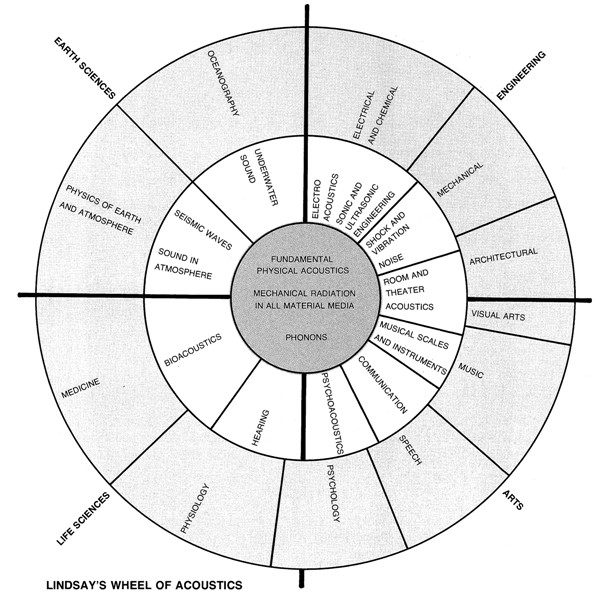
Acoustics can be confusing, here’s how to simplify it
For someone that is new to the world of acoustics, going to a conference like Internoise can be an eye-opener in terms of the width of disciplines that’s included under the umbrella of acoustics. Acoustic Bulletin focuses to a large degree on room acoustics, and we often find that people think of acoustics only in terms of one field like audio, but there is so much more involved.
IOA defines ‘acoustics’ as the science that deals with “the generation, transmission and reception of energy in the form of vibrational waves in matter”. But as they rightly mention, this definition fails to communicate the human side of acoustics, the fact that acoustics is all around us. Even before we are born, we are able to hear, and sound has an influence, both physiological and psychological, throughout our lives.
To help us get a better overview, Lindsay’s Acoustic Wheel was developed in the 60s by Bruce Lindsay.

Lindsay’s Acoustic Wheel describes acoustics as the science which deals with production, control, transmission, receptions and effects of sound. The wheel consists of four sections; Arts, Earth Sciences, Engineering and Life Sciences. The outer circle is described as the disciplines which one may choose to study for a career within acoustics, whereas the inner circle relates to the topics which the various disciplines naturally lead to.
Applying Lindsay’s Acoustic Wheel to healthcare design
In a recent podcast, we learnt how Sustainable Acoustics apply the wheel to architectural acoustics; assisting them to create building designs which help their users. The wheel also highlights how diverse the applications of acoustics are.
One section within Lindsay’s Acoustics Wheel is Medicine. This naturally links to healthcare and shows how we can use sound as a medicine. Our skin and bones both allow sound to infiltrate them, meaning sound can create a therapeutic effect on the body. As Peter Roberts discussed in our latest podcast this allows the patient to feel relaxed which is great because we have clearer thinking, better sleep and a better imagination when we are in a relaxed environment. When noise is reduced and sound used in a positive way, the sounds themselves can be considered nutrition for patients.
Another section of the wheel which reflects further into medical acoustics is bioacoustics. Bioacoustics can be described as the branch of acoustics concerned with sounds produced by or affecting living organisms, especially in relation to communication. Bioacoustics includes animal communication and associated behaviour, sound production anatomy and neurophysiology and the effects of human-made noise on animals. Although bioacoustics do not describe the way which you should create a ‘soundscape’ environment, an understanding of the effects of sound on living organisms such as ourselves can supplement building physics when developing healing environments.
The wheel has 11 main sections and 10 subsections within the circle relating to acoustics, and where acoustics should be considered. Discover the other sections within the wheel on Brigham Young University’s site.
Or listen to our new podcast, Health, wellbeing and the future of acoustic design to discover a deeper understanding of acoustics and how Lindsey’s acoustic wheel can be applied in healthcare.

